Index to Flowers in the Order Proteales
Family: Proteaceae
Diastella divaricata divaricata Peninsula Silkypuff https://africawild-forum.com/viewtopic.p ... 38#p313838
Leucadendron tinctum Spicy Conebush https://africawild-forum.com/viewtopic.p ... 84#p241884
Leucospermum calligerum Arid Pincushion https://africawild-forum.com/viewtopic.p ... 19#p242919
Leucospermum cordifolium Pincushion https://africawild-forum.com/viewtopic.p ... 08#p151749
Leucospermum erubescens Orange Flame Pincushion, Langeberg Pincushion https://africawild-forum.com/viewtopic.p ... 88#p152588
Leucospermum oleifolium Overberg Pincushion https://africawild-forum.com/viewtopic.p ... 80#p241880
Leucospermum reflexum Rocket Pincushion https://africawild-forum.com/viewtopic.p ... 78#p241878
Mimetes cucullatus Common Pagoda, Common Mimetes https://africawild-forum.com/viewtopic.p ... 34#p249934
Mimetes hirtus Marsh Pagoda, Red and yellow Bottlebrush https://africawild-forum.com/viewtopic.p ... 08#p171978
Protea cynaroides King Protea https://africawild-forum.com/viewtopic.p ... 08#p171982
Serruria rosea Rose Spiderhead, Bridesmaid Spiderhead https://africawild-forum.com/viewtopic.p ... 86#p241886
Index to Trees & Shrubs in the Order Proteales
Family: Proteaceae (Protea Family)
082. Leucadendron coniferum Dune Conebush https://africawild-forum.com/viewtopic.p ... 51#p177951
078. Leucadendron strobilinum Peninsula Conebush https://africawild-forum.com/viewtopic.p ... 80#p171674
084.1 Leucospermum conocarpodendron viridum Green Tree Pincushion https://africawild-forum.com/viewtopic.p ... 77#p171677
072.2 Mimetes fimbriifolius Tree Pagoda, Cowl Pagoda https://africawild-forum.com/viewtopic.p ... 01#p242801
087. Protea caffra caffra Common Sugarbush https://africawild-forum.com/viewtopic.p ... 79#p171679
90.2 Protea laurifolia Grey-leaf Sugarbush, Laurel-leaf Bearded-Protea https://africawild-forum.com/viewtopic.p ... 81#p171681
093.1 Protea neriifolia Oleanderleaf Protea, Narrow-leaf Sugarbush https://africawild-forum.com/viewtopic.p ... 87#p171687
093.1 Protea neriifolia "Niobe" White Oleanderleaf Protea https://africawild-forum.com/viewtopic.p ... 92#p171692
094.2 Protea repens Common Sugarbush https://africawild-forum.com/viewtopic.p ... 98#p171698
Africa Wild Flower Book - Order Proteales
Moderator: Klipspringer
- nan
- Posts: 26476
- Joined: Thu May 31, 2012 9:41 pm
- Country: Switzerland
- Location: Central Europe
- Contact:
Africa Wild Flower Book - Order Proteales
Pincushion Bobbejaanklou Leucospermum cordifolium (Luisiesboom)
Order: Proteales. Family: Proteaceae
 © nan
© nan
Kirstenbosch National Botanical Garden, Cape Town
Description
A rounded shrub with spreading or somewhat drooping branches may reach 1,5 m. Single main stem and horizontal drooping branches. Leaves variable in shape and size - smaller and entire towards branch tip. The leaves are oval, lobed at the base and with one to six teeth at the tips. The flowerheads grow in groups of up to three at the stem tips. Flowerheads deviate from spherical by being flattened above. The wiry styles are gracefully incurved. Blooming occurs from August to January. A few nut-like seeds are produced per flowerhead. Inflorescences borne at right angles to stem. Pollen presenter hoof-shaped. These are ant-distributed; ants feed on the external elaiosomes and store the seeds in the ground.
Distribution
It grows in the south-western parts from the Kogelberg and Sir Lowry’s Pass to around Caledon and the Bredasdorp area, on lower limestone and sandstone slopes in the fynbos.
Habitat
It grows in acid, nutrient poor soils in a fairly small area in the South Western Cape, and occurs only in the winter rainfall area with its wet winters from May to September and hot, dry summers from December to the end of February.
Links: PlantZAfrica; Protea Atlas
 © Tina
© Tina
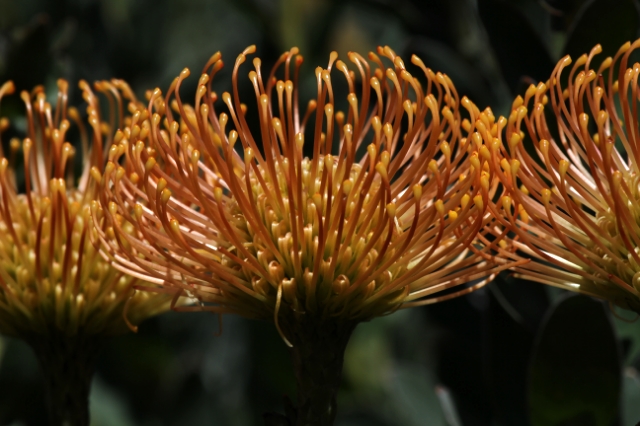 © Tina
© Tina
Kirstenbosch National Botanical Garden
Order: Proteales. Family: Proteaceae
 © nan
© nanKirstenbosch National Botanical Garden, Cape Town
Description
A rounded shrub with spreading or somewhat drooping branches may reach 1,5 m. Single main stem and horizontal drooping branches. Leaves variable in shape and size - smaller and entire towards branch tip. The leaves are oval, lobed at the base and with one to six teeth at the tips. The flowerheads grow in groups of up to three at the stem tips. Flowerheads deviate from spherical by being flattened above. The wiry styles are gracefully incurved. Blooming occurs from August to January. A few nut-like seeds are produced per flowerhead. Inflorescences borne at right angles to stem. Pollen presenter hoof-shaped. These are ant-distributed; ants feed on the external elaiosomes and store the seeds in the ground.
Distribution
It grows in the south-western parts from the Kogelberg and Sir Lowry’s Pass to around Caledon and the Bredasdorp area, on lower limestone and sandstone slopes in the fynbos.
Habitat
It grows in acid, nutrient poor soils in a fairly small area in the South Western Cape, and occurs only in the winter rainfall area with its wet winters from May to September and hot, dry summers from December to the end of February.
Links: PlantZAfrica; Protea Atlas
 © Tina
© Tina © Tina
© TinaKirstenbosch National Botanical Garden
Kgalagadi lover… for ever
https://safrounet.piwigo.com/
https://safrounet.piwigo.com/
Africa Wild Flower Book - Order Proteales
Orange Flame Pincushion, Langeberg Pincushion Leucospermum erubescens (Oranjevlamspeldekussing)
Order: Proteales. Family: Proteaceae
 © Dewi
© Dewi
Kirstenbosch National Botanical Garden
Description
Erect shrub to 2 m tall. It has a single main stem. Leaves are hairless, 7–9 mm long, and narrow, 1–2 mm wide, with nearly parallel sides. They end quite squarely, as if cut off, with 3 apical teeth, although they are occasionally rounded and can have up to 7 apical teeth. The flower heads are bright orange-red, large (50–65 mm wide), in twos or threes or in clusters of 4–8 at the tips of the branches. Each individual flower starts out yellow, when it opens the perianth tube curls back to reveal a bright crimson-red inside surface, and as the flower ages the parts that are yellow deepen and darken to orange-red. Flowering season is late winter, through spring into summer (August to January). Flower heads last on the bush for about 2 months.
Leucospermum erubescens is one of the Wide-tubed Pincushions: the perianth tube widens towards the upper end. In this group it can be distinguished because the flower heads have an obvious flower stalk (peduncle) 20–30 mm long; there is a distinct junction between the stalk and the flower head; and the flower heads are slightly asymmetrical, with the styles turned towards the axis.
Distribution
South African endemic, Western Cape: Langeberg from Muiskraal to Brandrivier, Warmwaterberg at Warmbad.
Habitat
Dry, arid, rocky hills and gravel flats, 500-670 m. Habitat specialist on north-facing slopes, it occurs only in North Langeberg Sandstone Fynbos.
Links: PlantZAfrica; Protea Atlas
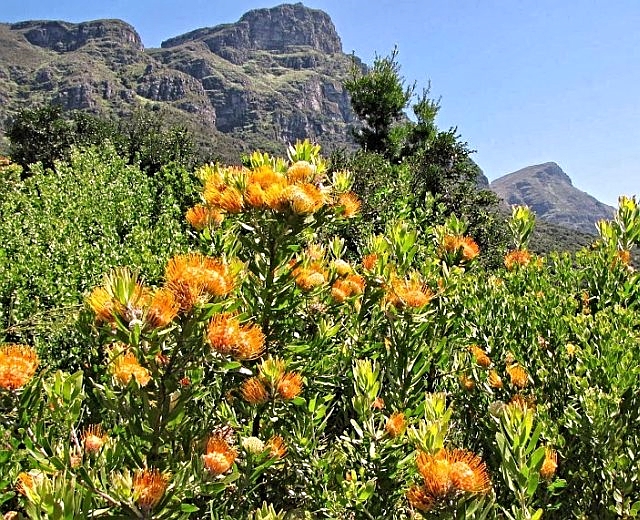 © Lisbeth
© Lisbeth
Kirstenbosch National Botanical Garden
 © Tina
© Tina
Kirstenbosch National Botanical Garden
Order: Proteales. Family: Proteaceae
 © Dewi
© DewiKirstenbosch National Botanical Garden
Description
Erect shrub to 2 m tall. It has a single main stem. Leaves are hairless, 7–9 mm long, and narrow, 1–2 mm wide, with nearly parallel sides. They end quite squarely, as if cut off, with 3 apical teeth, although they are occasionally rounded and can have up to 7 apical teeth. The flower heads are bright orange-red, large (50–65 mm wide), in twos or threes or in clusters of 4–8 at the tips of the branches. Each individual flower starts out yellow, when it opens the perianth tube curls back to reveal a bright crimson-red inside surface, and as the flower ages the parts that are yellow deepen and darken to orange-red. Flowering season is late winter, through spring into summer (August to January). Flower heads last on the bush for about 2 months.
Leucospermum erubescens is one of the Wide-tubed Pincushions: the perianth tube widens towards the upper end. In this group it can be distinguished because the flower heads have an obvious flower stalk (peduncle) 20–30 mm long; there is a distinct junction between the stalk and the flower head; and the flower heads are slightly asymmetrical, with the styles turned towards the axis.
Distribution
South African endemic, Western Cape: Langeberg from Muiskraal to Brandrivier, Warmwaterberg at Warmbad.
Habitat
Dry, arid, rocky hills and gravel flats, 500-670 m. Habitat specialist on north-facing slopes, it occurs only in North Langeberg Sandstone Fynbos.
Links: PlantZAfrica; Protea Atlas
 © Lisbeth
© LisbethKirstenbosch National Botanical Garden
 © Tina
© TinaKirstenbosch National Botanical Garden
Re: Africa Wild Flower Book - Order Proteales
Marsh Pagoda, Red and yellow Bottlebrush, Tall Pagoda, Hairy Mimetes, Pineapple Bush Mimetes hirtus (Kreupelboom, Vleistompie)
Order: Proteales. Family: Proteaceae

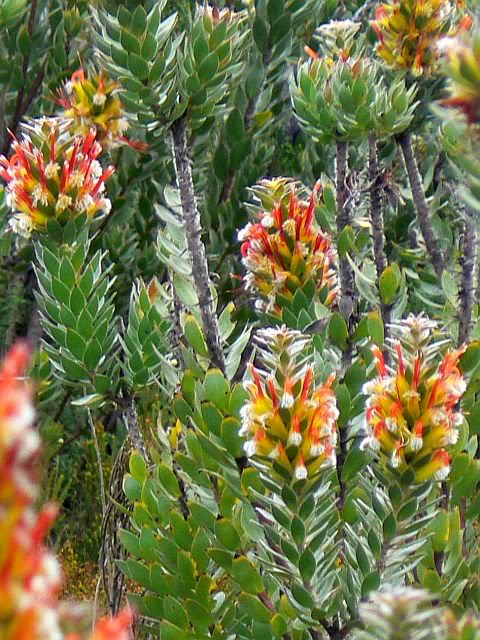
Table Mountain National Park, Cape Point
The genus Mimetes can readily be distinguished from all other Proteaceae by the dense heads of flowers formed by aggregating tubular, axillary, stalkless inflorescences (technically a pseudanthia), each containing 3-22 (35) florets and subtended by a leaf, into a large cylindrical inflorescence (technically a conflorescence). The perianth segments are almost entirely free and symmetrical. The style is hairless and is adorned by a distinctively-shaped pollen presenter in each species. Leaves are 1-3 toothed. The fruit is ovoid to cylindric, usually hairless to minutely hairy, with a prominent elaiosome at both ends joined by a thin ridge down one end.
Description
It is a single-stemmed, erect, much-branched shrub, 1-2.5 m in height with smooth, reddish bark. The branches possess numerous upwardly overlapping, leaveshide the stem almost completely. Leaves lanceolate to broadly lanceolate, 25-45 mm long. The leaves and stem are covered in tiny hairs, and the leaf edges are ciliate. The flower heads are borne in the axils of the uppermost foliage leaves of a flowering branch. There are nine to fourteen flowers in the headlet; each of these being surrounded by bright yellow, tube-shaped bracts with red tips, from which the 50-55 mm long red styles, needle-shaped pollen presenter and fluffy white extend. Flowering mainly in winter, in July and August. The fruit is a hard, greyish single seed, with a fleshy coat and a tough thickening at each end.
Distribution
Seven populationsin the Cape Peninsula and Houwhoek Centres of Endemism, where it is common at Cape Point and in Betty's Bay.
Habitat
Cape fynbos, endemic to the winter rainfall Cape Floral Region where it favours seeps and bogs in coastal lowlands and coastal mountain slopes (0-400 m).
Order: Proteales. Family: Proteaceae


Table Mountain National Park, Cape Point
The genus Mimetes can readily be distinguished from all other Proteaceae by the dense heads of flowers formed by aggregating tubular, axillary, stalkless inflorescences (technically a pseudanthia), each containing 3-22 (35) florets and subtended by a leaf, into a large cylindrical inflorescence (technically a conflorescence). The perianth segments are almost entirely free and symmetrical. The style is hairless and is adorned by a distinctively-shaped pollen presenter in each species. Leaves are 1-3 toothed. The fruit is ovoid to cylindric, usually hairless to minutely hairy, with a prominent elaiosome at both ends joined by a thin ridge down one end.
Description
It is a single-stemmed, erect, much-branched shrub, 1-2.5 m in height with smooth, reddish bark. The branches possess numerous upwardly overlapping, leaveshide the stem almost completely. Leaves lanceolate to broadly lanceolate, 25-45 mm long. The leaves and stem are covered in tiny hairs, and the leaf edges are ciliate. The flower heads are borne in the axils of the uppermost foliage leaves of a flowering branch. There are nine to fourteen flowers in the headlet; each of these being surrounded by bright yellow, tube-shaped bracts with red tips, from which the 50-55 mm long red styles, needle-shaped pollen presenter and fluffy white extend. Flowering mainly in winter, in July and August. The fruit is a hard, greyish single seed, with a fleshy coat and a tough thickening at each end.
Distribution
Seven populationsin the Cape Peninsula and Houwhoek Centres of Endemism, where it is common at Cape Point and in Betty's Bay.
Habitat
Cape fynbos, endemic to the winter rainfall Cape Floral Region where it favours seeps and bogs in coastal lowlands and coastal mountain slopes (0-400 m).
-
Sharifa
Re: Trees and Shrubs of Southern Africa
King Protea, King Shugarbush Protea cynaroides (Grootsuikerkan)
Order: Proteales. Family: Proteaceae
 © Sharifa
© Sharifa
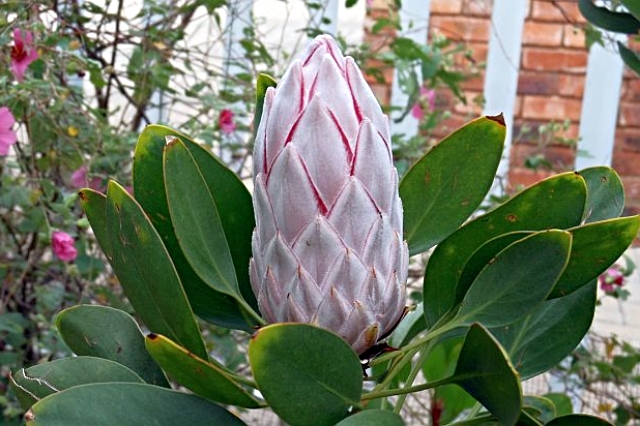 © Sharifa
© Sharifa
 © Sharifa
© Sharifa
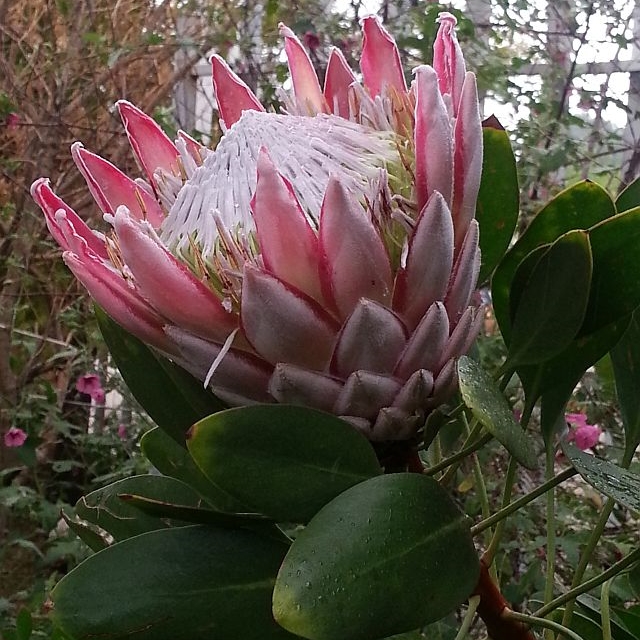 © Sharifa
© Sharifa
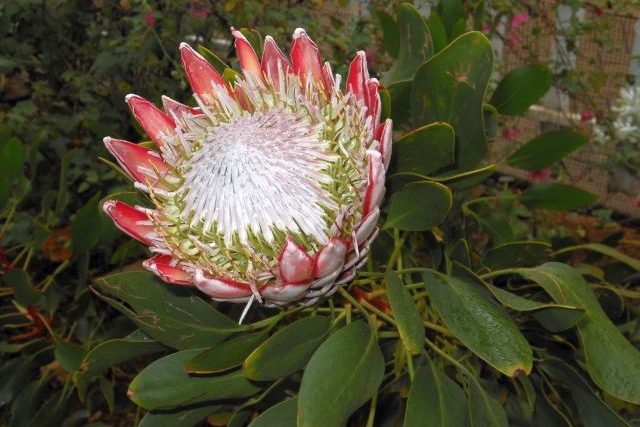 © Sharifa
© Sharifa
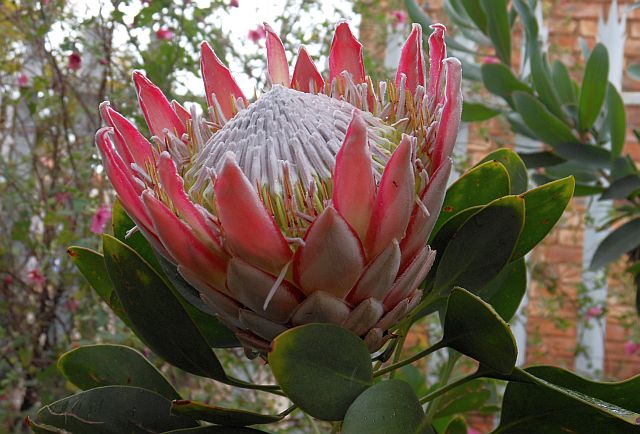 © Sharifa
© Sharifa
Protea cynaroides is part of an ancient plant family, the Proteaceae, which had already divided into two subfamilies before the break-up of the Gondwanaland continent about 140 million years ago.
Description
Protea cynaroides is a multi-stemmed upright shrub with thick stems and large dark green, glossy leaves. Most plants are one metre in height when mature, but may vary according to locality and habitat from 0.35 m to 2 m in height.
The "flowers" of Protea cynaroides are actually flower heads with a collection of flowers in the centre, surrounded by large colourful bracts. The flowerheads vary in size, from about 120 mm to 300 mm in diameter. Large, vigorous plants produce six to ten flower heads in one season, although some exceptional plants can produce up to forty flower heads on one plant. The colour of the bracts varies from a creamy white to a deep crimson.
The flowers in the centre of the flower head open over a fairly long period of time. The flowers are pollinated by Scarab Beetles and Protea Beetles and many other insects, as well as by birds. The birds are attracted by the nectar as well as by the insects visiting the flowers.
The large flower heads produce a disappointingly small amount of good seeds, only 1 - 30 percent of flowers result in seed. The plant's need to produce nutrient-rich seeds in a nutrient-poor environment is thought to limit the amount of seeds it can produce. The seeds are quite large nuts, covered by hairs and stay in the old flower head for a year or more. They are released after a fire and dispersed by rodents and birds.
Distribution
Protea cynaroides has one of the widest distribution ranges of all the Proteaceae and occurs from the Cedarberg in the northwest to Grahamstown in the east.
Habitat
It occurs on all mountain ranges in this area, except for the dry interior ranges, and at all elevations, from sea level to 1500 m high. The combination of the different climatic conditions with the large range of localities has resulted in a large variety of leaf- and flower sizes, as well as flower colours and flowering times. The different forms retain these characteristics even when grown under the same conditions on a commercial scale.
Protea cynaroides occurs in fire prone vegetation, where natural fires occur every ten to thirty years. This 'Mediterranean' type of vegetation grows in soils with very low amounts of nutrients. These nutrients are used up by the plants during their lifetime and need to be returned to the soil to provide the food for a new generation of plants. Protea cynaroides is adapted to survive the fires by its thick underground stem, which contains many dormant buds; these will produce the new growth after the fire.
Links: Protea Atlas
 © Tina
© Tina
Kirstenbosch National Botanical Garden
Order: Proteales. Family: Proteaceae
 © Sharifa
© Sharifa © Sharifa
© Sharifa © Sharifa
© Sharifa © Sharifa
© Sharifa © Sharifa
© Sharifa © Sharifa
© SharifaProtea cynaroides is part of an ancient plant family, the Proteaceae, which had already divided into two subfamilies before the break-up of the Gondwanaland continent about 140 million years ago.
Description
Protea cynaroides is a multi-stemmed upright shrub with thick stems and large dark green, glossy leaves. Most plants are one metre in height when mature, but may vary according to locality and habitat from 0.35 m to 2 m in height.
The "flowers" of Protea cynaroides are actually flower heads with a collection of flowers in the centre, surrounded by large colourful bracts. The flowerheads vary in size, from about 120 mm to 300 mm in diameter. Large, vigorous plants produce six to ten flower heads in one season, although some exceptional plants can produce up to forty flower heads on one plant. The colour of the bracts varies from a creamy white to a deep crimson.
The flowers in the centre of the flower head open over a fairly long period of time. The flowers are pollinated by Scarab Beetles and Protea Beetles and many other insects, as well as by birds. The birds are attracted by the nectar as well as by the insects visiting the flowers.
The large flower heads produce a disappointingly small amount of good seeds, only 1 - 30 percent of flowers result in seed. The plant's need to produce nutrient-rich seeds in a nutrient-poor environment is thought to limit the amount of seeds it can produce. The seeds are quite large nuts, covered by hairs and stay in the old flower head for a year or more. They are released after a fire and dispersed by rodents and birds.
Distribution
Protea cynaroides has one of the widest distribution ranges of all the Proteaceae and occurs from the Cedarberg in the northwest to Grahamstown in the east.
Habitat
It occurs on all mountain ranges in this area, except for the dry interior ranges, and at all elevations, from sea level to 1500 m high. The combination of the different climatic conditions with the large range of localities has resulted in a large variety of leaf- and flower sizes, as well as flower colours and flowering times. The different forms retain these characteristics even when grown under the same conditions on a commercial scale.
Protea cynaroides occurs in fire prone vegetation, where natural fires occur every ten to thirty years. This 'Mediterranean' type of vegetation grows in soils with very low amounts of nutrients. These nutrients are used up by the plants during their lifetime and need to be returned to the soil to provide the food for a new generation of plants. Protea cynaroides is adapted to survive the fires by its thick underground stem, which contains many dormant buds; these will produce the new growth after the fire.
Links: Protea Atlas
 © Tina
© TinaKirstenbosch National Botanical Garden
Re: Africa Wild Flower Book - Order Proteales
Rocket Pincushion, Sky-rocket Pincushion Leucospermum reflexum (Perdekop)
Order: Proteales. Family: Proteaceae
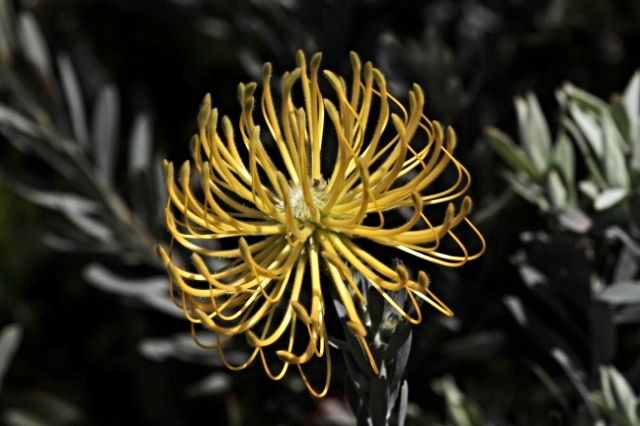 © Tina
© Tina
Leucospermum reflexum lutea, Kirstenbosch National Botanical Garden
Description
Leucospermum reflexum is a rounded, silvery grey-leaved shrub up to 4 m tall with either yellow (var. lutea) or deep orange to crimson (var. reflexum) flower heads which flower from spring to midsummer in the southern hemisphere (August to December). The more or less elliptic, simple leaves are covered with dense grey hairs. They are about 20-55 x 5-13 mm, with 2-3 glandular teeth at the tip. The rounded flower heads occur at the ends of the branches and are between 80-100 mm across. Each flower is tube-like and made up of velvety floral parts called the perianth segments on which the anthers are placed. These surround the long style which escapes from the tube to form the 'pin' and the perianths then curl away from it. Young flowers are curved to start with, and then bend back toward the stem as they mature. The common name of rocket pincushion is very apt because these downward bent styles look like the fiery tail of a rocket trailing behind it.
The seeds ripen about 1-2 months after flowering and are then released.
Distribution
South African endemic, Western Cape: Although the general area in the Cederberg, from Wuppertal to Pakhuis where the plants occur, tends to be arid, these plants are found on sandstone soils. The plants usually occur in groups of a few hundred at altitudes ranging between 1 000-2 000 m. The yellow variety comes from the Heuningvlei area in the Cederberg.
Habitat
Sandy soils, near streams, 1000-2000 m.
Links: PlantZAfrica; Protea Atlas
Order: Proteales. Family: Proteaceae
 © Tina
© TinaLeucospermum reflexum lutea, Kirstenbosch National Botanical Garden
Description
Leucospermum reflexum is a rounded, silvery grey-leaved shrub up to 4 m tall with either yellow (var. lutea) or deep orange to crimson (var. reflexum) flower heads which flower from spring to midsummer in the southern hemisphere (August to December). The more or less elliptic, simple leaves are covered with dense grey hairs. They are about 20-55 x 5-13 mm, with 2-3 glandular teeth at the tip. The rounded flower heads occur at the ends of the branches and are between 80-100 mm across. Each flower is tube-like and made up of velvety floral parts called the perianth segments on which the anthers are placed. These surround the long style which escapes from the tube to form the 'pin' and the perianths then curl away from it. Young flowers are curved to start with, and then bend back toward the stem as they mature. The common name of rocket pincushion is very apt because these downward bent styles look like the fiery tail of a rocket trailing behind it.
The seeds ripen about 1-2 months after flowering and are then released.
Distribution
South African endemic, Western Cape: Although the general area in the Cederberg, from Wuppertal to Pakhuis where the plants occur, tends to be arid, these plants are found on sandstone soils. The plants usually occur in groups of a few hundred at altitudes ranging between 1 000-2 000 m. The yellow variety comes from the Heuningvlei area in the Cederberg.
Habitat
Sandy soils, near streams, 1000-2000 m.
Links: PlantZAfrica; Protea Atlas
Re: Africa Wild Flower Book - Order Proteales
Overberg Pincushion Leucospermum oleifolium
Order: Proteales. Family: Proteaceae
 © Tina
© Tina
Kirstenbosch National Botanical Garden
Description
Erect rounded shrub up to 1m tall and about 1.5 m in diameter. It has a single main stem and forms a compact bush. The broad leaves are silvery-grey, hairless or hairy; oval to lance-shaped, 40-60 mm long with 1-5 apical teeth. The inflorescences are about 4 cm across, in clusters of up to five individual flat-topped flowerheads at the end of the branches. The flowerheads open as a pale yellow, which soon turns orange and becomes a brilliant crimson with age. The style is straight and 25-30 mm long. Flowers: August to January, mainly September and October.
This species belongs to the group of leucospermums known as the 'Flat Pincushions' as they do not curl at the tips.
Distribution
South African endemic, Western Cape: Slanghoek, Du Toits Kloof, Riviersonderend, Hottentots Holland, Kleinmond, Groenland Mountains and Caledon.
Habitat
Sandstone sands, on slopes, 0 -1000 m.
Links: Protea Atlas; Field Guide to Fynbos
Order: Proteales. Family: Proteaceae
 © Tina
© TinaKirstenbosch National Botanical Garden
Description
Erect rounded shrub up to 1m tall and about 1.5 m in diameter. It has a single main stem and forms a compact bush. The broad leaves are silvery-grey, hairless or hairy; oval to lance-shaped, 40-60 mm long with 1-5 apical teeth. The inflorescences are about 4 cm across, in clusters of up to five individual flat-topped flowerheads at the end of the branches. The flowerheads open as a pale yellow, which soon turns orange and becomes a brilliant crimson with age. The style is straight and 25-30 mm long. Flowers: August to January, mainly September and October.
This species belongs to the group of leucospermums known as the 'Flat Pincushions' as they do not curl at the tips.
Distribution
South African endemic, Western Cape: Slanghoek, Du Toits Kloof, Riviersonderend, Hottentots Holland, Kleinmond, Groenland Mountains and Caledon.
Habitat
Sandstone sands, on slopes, 0 -1000 m.
Links: Protea Atlas; Field Guide to Fynbos
Re: Africa Wild Flower Book - Order Proteales
Spicy Conebush Leucadendron tinctum (Toffie-appel)
Order: Proteales. Family: Proteaceae
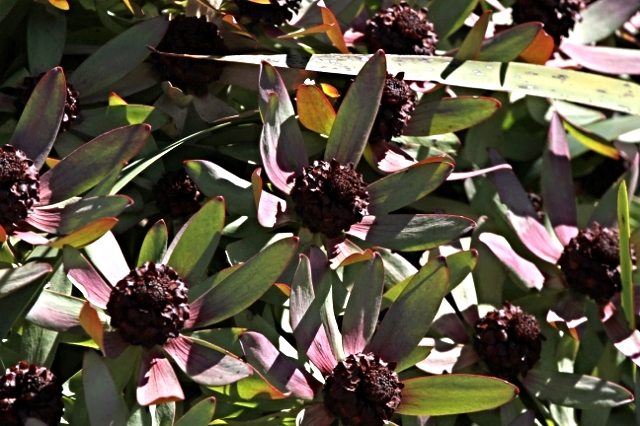 © Tina
© Tina
Kirstenbosch National Botanical Garden
Description
A perennial, erect shrub to 1.3 m tall. The plant grows from a single stem at the base with side branches bearing oblong, elliptical leaves. The leaves are a pale grey-green and during flowering, end in colourful bracts which surround the inflorescence. The male and female inflorescences are borne on separate plants. The flowers are arranged up of a single terminal head. The male flowerhead is yellow, whereas the female flowerhead is a shiny maroon surrounded by 50 oily basal scales. The flowering period for the spicy conebush is in July. Flowers have a pleasant spicy, musk scent, which gives rise to its common name. The female fruiting cones are maroon and contain round nut-like fruits.
Distribution
Leucadendron tinctum is one of the Cape Flora's plants which has a very wide distribution, its distribution covers a rather large area of the Cape, starting on the Agulhas plain and ending in the Langeberg. The plants occur in stony, sandstone soils at an altitude of 20-300 m. Populations have been seen in Potberg, Elim and the Bredasdorp flats to Kleinmond, Groenland, the eastern Hottentots-Holland Mountains and Stettynskloof Mountains. Their higher distribution includes Gysmanshoek, Garcia's and Robinson's Passes, the Swartberg and Rooiberg Passes and Matroosberg in the Hex River Mountains.
Habitat
Stony, sandstone soils, 300-1000 m.
Links: PlantZAfrica; Protea Atlas
Order: Proteales. Family: Proteaceae
 © Tina
© TinaKirstenbosch National Botanical Garden
Description
A perennial, erect shrub to 1.3 m tall. The plant grows from a single stem at the base with side branches bearing oblong, elliptical leaves. The leaves are a pale grey-green and during flowering, end in colourful bracts which surround the inflorescence. The male and female inflorescences are borne on separate plants. The flowers are arranged up of a single terminal head. The male flowerhead is yellow, whereas the female flowerhead is a shiny maroon surrounded by 50 oily basal scales. The flowering period for the spicy conebush is in July. Flowers have a pleasant spicy, musk scent, which gives rise to its common name. The female fruiting cones are maroon and contain round nut-like fruits.
Distribution
Leucadendron tinctum is one of the Cape Flora's plants which has a very wide distribution, its distribution covers a rather large area of the Cape, starting on the Agulhas plain and ending in the Langeberg. The plants occur in stony, sandstone soils at an altitude of 20-300 m. Populations have been seen in Potberg, Elim and the Bredasdorp flats to Kleinmond, Groenland, the eastern Hottentots-Holland Mountains and Stettynskloof Mountains. Their higher distribution includes Gysmanshoek, Garcia's and Robinson's Passes, the Swartberg and Rooiberg Passes and Matroosberg in the Hex River Mountains.
Habitat
Stony, sandstone soils, 300-1000 m.
Links: PlantZAfrica; Protea Atlas
Re: Africa Wild Flower Book - Order Proteales
Rose Spiderhead, Bridesmaid Spiderhead Serruria rosea (Strooimeisie, Bruidsbos)
Order: Proteales. Family: Proteaceae
 © Tina
© Tina
Kirstenbosch National Botanical Garden
Description
An erect shrub growing 0.8–1.5 m tall with clusters of 15—20 pink, hairy-edged flowers. Leaves curve upwards and are finely divided, measuring 30–60 mm long. They are hairless and have fine points on the tips. Spherical flower heads are clustered at the ends of branches and are cream in bud, opening to rose-pink and darkening with age. Flower heads open from the tip of the branch downwards, giving a long-lasting flowering display. The style is about 11 mm long and the pollen presenter is club-shaped. The perianth is covered with long, silver, silky hairs giving a fluffy look to the flower head. Pink involucral bracts are large, 8–25 mm long, and have a hairy margin. Flowering occurs from August–October and seeds (technically they are fruits) are released two months after flowering.
Distribution
Restricted to the Western Cape where it is endemic to Hawequas Sandstone Fynbos. Its natural distribution is from the Du Toitskloof to the Riviersonderend Mountains with an area of occurrence of about 51 km².
Habitat
A fynbos species. On the mountains it grows in dense isolated stands on sandy slopes at an altitude of between 300 and 620 m.
Links: PlantZAfrica; Protea Atlas
Order: Proteales. Family: Proteaceae
 © Tina
© TinaKirstenbosch National Botanical Garden
Description
An erect shrub growing 0.8–1.5 m tall with clusters of 15—20 pink, hairy-edged flowers. Leaves curve upwards and are finely divided, measuring 30–60 mm long. They are hairless and have fine points on the tips. Spherical flower heads are clustered at the ends of branches and are cream in bud, opening to rose-pink and darkening with age. Flower heads open from the tip of the branch downwards, giving a long-lasting flowering display. The style is about 11 mm long and the pollen presenter is club-shaped. The perianth is covered with long, silver, silky hairs giving a fluffy look to the flower head. Pink involucral bracts are large, 8–25 mm long, and have a hairy margin. Flowering occurs from August–October and seeds (technically they are fruits) are released two months after flowering.
Distribution
Restricted to the Western Cape where it is endemic to Hawequas Sandstone Fynbos. Its natural distribution is from the Du Toitskloof to the Riviersonderend Mountains with an area of occurrence of about 51 km².
Habitat
A fynbos species. On the mountains it grows in dense isolated stands on sandy slopes at an altitude of between 300 and 620 m.
Links: PlantZAfrica; Protea Atlas
Re: Africa Wild Flower Book - Order Proteales
Arid Pincushion Leucospermum calligerum (Luisiebossie)
Order: Proteales. Family: Proteaceae
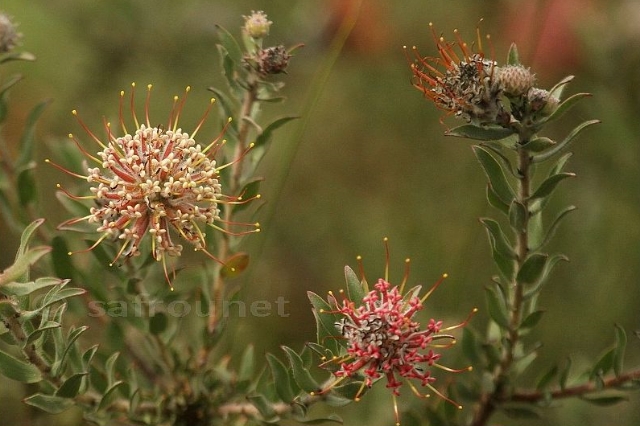 © nan
© nan
Bontebok National Park
Description
An erect to almost erect shrub to 2 m tall. A Louse Pincushion with hairy, lance-shaped to elliptical grey leaves 12-26 mm long, with 1(3) apical teeth; bears globular flowerheads 20-35 mm in diameter, cream-coloured, fading to dull red; the style is slightly curved inwards, 21-25 mm long. Both sexes in each flower. Flowering from July to January. The fruit is released 2 months after flowering.
Distribution
Endemic to the the southwestern Cape: Bokkeveld escarpment, Gifberg to Olifants River to Bredasdorp Mountains, Bonteberg to Langeberg, Riversdale Flats, Potberg.
Habitat
Hot, dry flats and northern slopes, 150-1350 m
Links: Protea Atlas; Field Guide to Fynbos. John C. Manning
Order: Proteales. Family: Proteaceae
 © nan
© nanBontebok National Park
Description
An erect to almost erect shrub to 2 m tall. A Louse Pincushion with hairy, lance-shaped to elliptical grey leaves 12-26 mm long, with 1(3) apical teeth; bears globular flowerheads 20-35 mm in diameter, cream-coloured, fading to dull red; the style is slightly curved inwards, 21-25 mm long. Both sexes in each flower. Flowering from July to January. The fruit is released 2 months after flowering.
Distribution
Endemic to the the southwestern Cape: Bokkeveld escarpment, Gifberg to Olifants River to Bredasdorp Mountains, Bonteberg to Langeberg, Riversdale Flats, Potberg.
Habitat
Hot, dry flats and northern slopes, 150-1350 m
Links: Protea Atlas; Field Guide to Fynbos. John C. Manning


